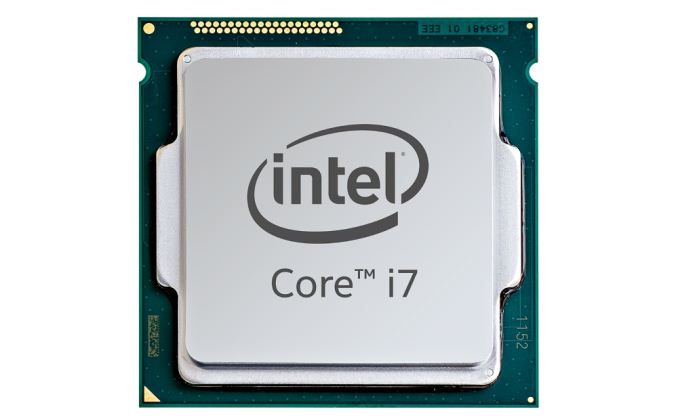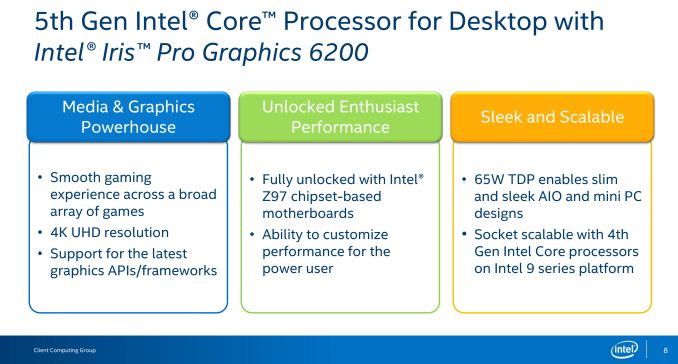The Intel Broadwell Desktop Review: Core i7-5775C and Core i5-5675C Tested (Part 1)
by Ian Cutress on June 2, 2015 7:45 AM ESTBroadwell-DT: Initial Thoughts
The new Broadwell desktop processors are somewhat out of sync with our regular expectations from Intel. Due to issues surrounding the 14nm node, as well as the cost, the whole Broadwell line from tablet to table-top has come out slower and more staggered than any Intel release in recent memory. As a result, the initial launch from Intel today is a pair of 65W desktop socketed models backed up with three 65W soldered down models whose true heritage is a chip primarily designed for large laptops and all-in-one devices.
Normally we would expect a range of desktop models from 35W up to 88W or higher, but socketed Broadwell-DT today only exhibits two units at 65W. This immediately puts a slight damper on those expecting to upgrade from Haswell’s high-end, or those wanting to go from something like a Pentium G3258 on Haswell to Broadwell’s top SKU. As a result, we have to keep our expectations in check – 65W should on paper perform nearly as well as an 88W part would, except it would be reduced by several hundred MHz. Meanwhile as these processors are also fully-unlocked and overclockable, we're left to ponder whether or not the stock frequencies actually matter in that case.
Due to the differential tangent at play, these processors also exhibit Intel’s best integrated graphics package, Iris Pro (GT3e), previously reserved only for soldered down/laptop/mini-PC orientations. This graphics package comes with largest number of execution units available from Intel, 48, alongside 128MB of eDRAM that acts almost like an L4 cache. This helps alleviate memory bandwidth pressure by providing a large(ish) pool near the CPU but with lower latency and much greater bandwidth than main memory. The eDRAM has the greatest effect in graphics, but we also saw some moderate increases in our non-3D regular benchmark suite.
The benefit of the graphics package, Iris Pro 6200, means that Broadwell-DT takes the crown as the fastest socketed graphics available. Our testing showed that the even the second-tier socketed SKU, the i5-5675C, outgunned the previous title holder, AMD’s A10-7870K. Despite having the i7-5775C in to test, due to time and firmware issues, we were unable to run the numbers on the integrated graphics but will do so in a later piece.
The key element to Broadwell-DT is not to consider it a natural successor to Haswell. It doesn't so much replace Haswell-K at this time, so much as it occupies a space Intel has left neglected since the launch of Haswell – the ultimate Intel integrated graphics solution. For users on integrated graphics, where money is no object, Intel now offers you the option to combine the regular CPU performance associated with Intel and a GPU that has the added performance benefits of on-chip, high-bandwidth eDRAM. The only question is whether that combined performance is worth the potential cost, and some would say no, pointing at a combined APU + GPU solution for equivalent or better gaming performance for the same price.
Pricing for the i5-5675C is listed as $276, slightly higher than the price of the i5-4690K which is at $236 on Amazon (reduced from $265). The i7-5775C is a bit higher at $366, also a margin higher than the i7-4790K which is $339 (reduced from $380). This makes Broadwell a tough sell right now in most circumstances unless you are absolutely limited to integrated graphics and want the best solution possible in a configurable PC. Given that Intel has also mentioned Skylake in their recent Computex keynote, it implements an abnormal situation that Intel has never been in with a new platform being talked about in the same breath. We have been told that these parts exist because users wanted them, and it has been interesting to see just how the added eDRAM changes the performance with discrete graphics in the mix.












196 Comments
View All Comments
ES_Revenge - Monday, July 13, 2015 - link
So over a month later...this seems like it was quite the paper launch. Not only have we not seen "part 2" of this review (with OC results), it doesn't seem like you can actually *buy* one of the CPUs anywhere.Best I seem to have found is Amazon but they show it's not even going to be in stock until mid-August! Won't Skylake be around by then? Intel really doesn't care about Broadwell I guess--you have to wonder why they even bothered.
tania420 - Thursday, July 30, 2015 - link
I like this. Intel always create dynamical product. For Intel lover here i7-4790k Reviews visit <a herf=” http://www.xiontech.net/”>here</a>tania420 - Thursday, July 30, 2015 - link
I agree, the obvious thing to do is use the price as it is during the time the article was written. For Intel i7-4790k reviews visit <a href=” http://www.xiontech.net/”> here</a>Gadgety - Sunday, August 2, 2015 - link
So I got the A8-7600 for $93 including shipping and 25% sales tax for the kids. The i5-5675C is $348 with shipping and the same sales tax. With the i5 the gaind would be 7-9 fps in GTA V, 6fps in GRID Autosport, and about 0% in Battlefield4 (A8-7600 34fps, 1920x1080, medium detail, with Mantle 14.6), for an additional $255, that is.felipetga - Wednesday, August 30, 2017 - link
Would it work on a H81 chipset motherboard?yeeeeman - Saturday, March 14, 2020 - link
Well, who would've known at that time of the review (year 2015) that this slow to bring-up process, that is 14nm will be in service so many years and still is today, year 2020.I think Intel should've reconsidered their plans for 10nm, after seeing how slow 14nm ramped, but probably management was somewhat communistic with the engineers.